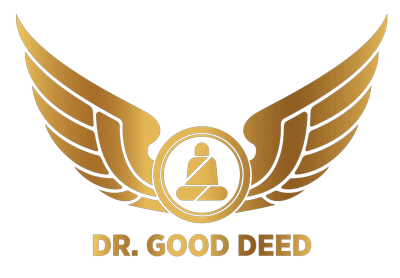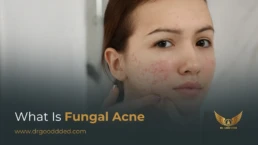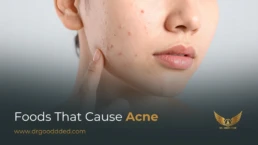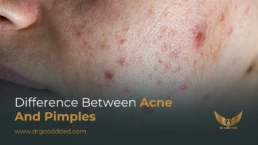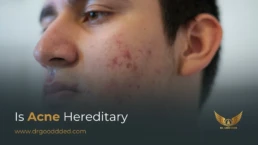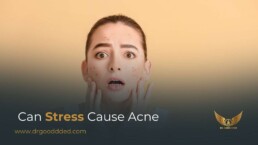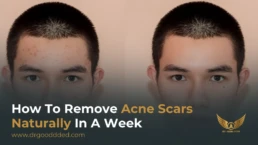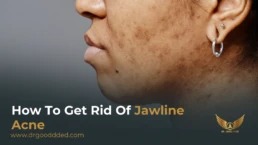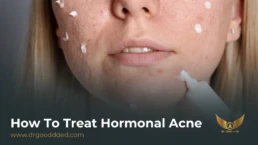Treating fungal acne effectively begins with understanding what it truly is. Many people think they have regular acne when it’s actually a yeast-related skin condition called malassezia folliculitis (a yeast infection of the hair follicles).
Table of Contents
ToggleThis type of acne can appear anywhere you sweat (on your face, back, shoulders, or chest), and it often worsens after workouts or in humid weather. If you’ve been using acne creams and seeing no results, this guide is your complete, expert-approved plan to recognize, treat, and prevent fungal acne for good.
What Is Fungal Acne?
Fungal acne is caused by an overgrowth of yeast on your skin. It’s not the same as bacterial acne, even though both look similar. The yeast responsible is called Malassezia , which naturally lives on the skin but sometimes multiplies too much, clogging hair follicles and causing itchy red bumps.
Medical Name: Malassezia Folliculitis
The medical term for fungal acne is malassezia folliculitis , meaning inflammation of hair follicles caused by yeast. These bumps are usually the same size, slightly red, and can be itchy or feel like a mild rash.
Difference Between Fungal Acne and Bacterial Acne
Regular bacterial acne forms due to excess oil and bacteria blocking pores. It often leads to whiteheads or blackheads. Fungal acne, however, appears as uniform bumps without any white or black tips. It also itches, which is rare in regular acne. If your acne worsens with sweat or you feel constant itchiness, chances are it’s fungal, not bacterial.
How Common Is Fungal Acne in the U.S.?
Fungal acne is more common than you think. Many dermatologists say up to 20% of acne cases are actually fungal. It’s seen often in warm, humid places like Florida, Texas, and Hawaii, and among gym-goers or people who sweat a lot.
What It Looks Like
These bumps are tiny, red, and often found on oily or sweaty areas like your chest, back, shoulders, and sometimes the face. Unlike pimples that come and go, fungal acne tends to stay and spread if not treated correctly.
What Causes Fungal Acne?

Overgrowth of Malassezia Yeast
Yeast on your skin grows naturally, but too much of it leads to fungal acne treatment needs. The overgrowth happens when your skin stays oily or sweaty for too long, giving yeast the perfect condition to thrive.
Hot, Humid Climates or Excessive Sweating
Sweat is one of the biggest triggers. Humid environments make it hard for sweat to evaporate, keeping your skin damp and encouraging yeast growth.
Tight, Non-Breathable Clothing
Tight gym wear or synthetic fabrics trap heat and sweat, letting yeast multiply. Loose cotton or moisture-wicking clothes are better for keeping your skin dry.
Antibiotic or Steroid Use
Antibiotics can destroy good bacteria on your skin, leaving yeast unchecked. Long-term steroid use can also upset the skin’s balance, promoting yeast growth and triggering what causes fungal acne in many people.
Weakened Immune System or Hormonal Imbalance
When your immune system is low or your hormones fluctuate, yeast can grow more easily. This can happen after illness, stress, or hormonal changes like puberty.
Symptoms of Fungal Acne
- Small, same-sized red bumps that itch
- Usually appear on the chest, back, shoulders, or upper arms
- No blackheads or whiteheads
- Worse after sweating or humidity
These symptoms make fungal acne easy to confuse with heat rash or regular acne. But the itchiness and uniform size of bumps are telltale signs.
How Is Fungal Acne Diagnosed?
Dermatological Examination
A dermatologist will look closely at your skin pattern, ask about your skincare products, sweating habits, and antibiotic use.
Skin Scraping or Biopsy
They may take a small scraping from your skin and look under a microscope to check for yeast cells.
Wood’s Lamp Test
Under special light, yeast may glow a faint yellow or blue color, confirming fungal acne treatment is needed.
Self-Check vs. Professional Diagnosis
You can suspect fungal acne if your bumps are itchy, small, and worsen with sweat. But to be sure, only a dermatologist can confirm it.
Treatment Options for Fungal Acne
Treating fungal acne means fighting yeast, not bacteria. This is where many people go wrong; antibiotic creams won’t help and can even worsen the condition.
Topical Antifungal Creams
Creams like Ketoconazole (Nizoral), Clotrimazole, or Ciclopirox are first-line treatments. Apply them twice daily for 2–4 weeks. These creams kill yeast directly on the skin.
Oral Antifungal Medications
For severe or widespread fungal acne, doctors may prescribe Fluconazole or Itraconazole. These pills target yeast internally and clear the skin faster. However, they must be used under medical supervision.
Over-The-Counter Products
Anti-dandruff shampoos with selenium sulfide or zinc pyrithione can double as antifungal body washes. You can use them during showers and leave them on the skin for 2–3 minutes before rinsing. Sulfur-based soaps also work well.
Avoiding Antibiotics or Oily Skincare Products
Antibiotics can worsen fungal acne. Also, skip heavy moisturizers or oily sunscreens. Instead, go for lightweight, gel-based skincare that doesn’t trap moisture.
| Treatment Type | Example Products | Works Best For | Notes |
| Topical Creams | Ketoconazole, Clotrimazole | Mild to Moderate Acne | Apply 2x daily |
| Oral Medication | Fluconazole, Itraconazole | Severe Acne | Requires prescription |
| OTC Washes | Selenium Sulfide, Zinc Pyrithione | Body Acne | Use daily for 5 min |
How to Treat Fungal Acne at Home: Home Remedies
Home care plays a huge role in your fungal acne treatment at home plan. Here’s what works best:
Shower Immediately After Workouts
Yeast loves sweat. Showering right after exercise washes away sweat and prevents yeast buildup.
Use Antifungal Body Washes
Use shampoos containing zinc pyrithione or selenium sulfide as body washes two to three times a week. Lather it, leave for 3 minutes, then rinse.
Change Sweaty Clothes Quickly
Never stay in sweaty gym clothes. Change into clean, dry clothing after workouts to keep yeast away.
Maintain a Clean, Dry Skin Barrier
Keep your skin clean but not stripped of natural oils. Use mild cleansers, pat dry with a towel, and use non-oily moisturizers if needed.
When NOT to Rely on Home Remedies
If symptoms persist for more than 2 weeks or the rash spreads, home remedies alone may not be enough. You’ll need prescription antifungal medications.
Preventing Fungal Acne
Maintain a Balanced Skin Microbiome
Use gentle cleansers that don’t disrupt natural skin bacteria. Avoid harsh scrubs or alcohol-based toners.
Choose Breathable Fabrics and Lightweight Skincare
Cotton, linen, or moisture-wicking materials help your skin breathe. Oil-free and fragrance-free skincare keeps your pores clear.
Avoid Unnecessary Antibiotics or Steroids
Use these only when prescribed and necessary. Overuse can upset your skin’s microbial balance and cause yeast overgrowth.
Stay Hydrated and Eat a Balanced Diet
Drink enough water daily and eat foods rich in vitamins A, C, and zinc for skin repair. A healthy gut can also help regulate skin balance.
Can Fungal Acne Come Back?
Yes, it can return if yeast grows again due to sweat, humidity, or excess oil. Once you know how to treat fungal acne , maintaining the results becomes key.
How to Prevent Relapse
Use antifungal washes once a week as maintenance, especially during summer. Avoid wearing tight clothes for long hours.
Long-Term Maintenance Plan
Keep your skin routine simple: antifungal wash weekly, gentle cleanser daily, and non-comedogenic (non-pore-clogging) moisturizer. This plan keeps yeast under control long-term.
When to See a Dermatologist
- If acne doesn’t improve after OTC antifungal use
- If the rash spreads, burns, or becomes painful
- If symptoms worsen after antibiotic use
- If you need oral antifungal medications
During a consultation, the dermatologist will review your skin, might do a scraping test, and design a personalized plan based on your skin type.
Possible Side Effects of Fungal Acne Treatment
- Mild irritation or dryness from antifungal creams
- Rare allergic reactions to ingredients
- Nausea or headache from oral medications
- Importance of following your doctor’s dosage instructions
Always patch-test new creams to avoid reactions.
Living With Fungal Acne
Daily Skincare Routine for Sensitive Skin
Wash gently twice daily, avoid harsh scrubs, and moisturize lightly. Use antifungal shampoo as a body wash weekly.
Stress and Hormonal Impact
Stress changes hormone levels and oil production, which may trigger yeast growth. Simple activities like deep breathing or walking can help reduce flare-ups.
How Long Does Recovery Take?
Mild cases can clear in 2–4 weeks with consistent treatment. More severe cases may take 2 months or longer.
Realistic Expectations for Long-Term Control
You can manage fungal acne completely with the right habits. While it may recur in humid conditions, proper care keeps it under control.
Frequently Asked Questions
Is fungal acne contagious?
No, fungal acne isn’t contagious. It comes from yeast that already lives on your skin, not from contact with another person.
Can stress cause fungal acne?
Yes, stress can alter hormones and oil balance, which may allow yeast to grow faster and worsen symptoms.
Does diet affect fungal acne?
While no single diet cures it, eating low-sugar foods and staying hydrated can support better skin balance.
How long does it take for fungal acne to clear?
Results vary, but with correct treatment, visible improvement usually appears within 2 to 4 weeks of consistent care.
Can fungal acne be cured permanently?
You can control it for the long term, but yeast naturally lives on the skin, so maintaining preventive care is key.
What products should I avoid if I have fungal acne?
Avoid oily, greasy skincare or heavy sunscreens. These create a moist surface that encourages yeast growth.
Is fungal acne more common in athletes or gym-goers?
Yes, since athletes sweat more, yeast growth is higher, making fungal acne more common in that group.
Can you use salicylic acid and antifungal cream together?
Yes, salicylic acid can exfoliate dead skin, and antifungal cream targets yeast. Use both under your dermatologist’s guidance.
How to differentiate fungal acne from hormonal acne?
Fungal acne itches and has small, even bumps. Hormonal acne causes deeper, painful cysts around the jawline.
Are natural antifungal oils (tea tree, coconut) safe?
Tea tree oil may help mild cases, but coconut oil can worsen fungal acne since yeast feeds on it. Always do a patch test.

This article is medically reviewed by Dr. Nivedita Pandey, Senior Gastroenterologist and Hepatologist, ensuring accurate and reliable health information.
Dr. Nivedita Pandey is a U.S.-trained gastroenterologist specializing in pre and post-liver transplant care, as well as managing chronic gastrointestinal disorders. Known for her compassionate and patient-centered approach, Dr. Pandey is dedicated to delivering the highest quality of care to each patient.
